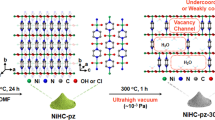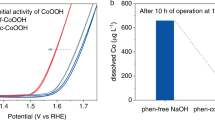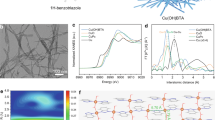Abstract
Enzymes feature the concerted operation of multiple components around an active site, leading to exquisite catalytic specificity. Realizing such configurations on synthetic catalyst surfaces remains elusive. Here, we report a nanoparticle/ordered-ligand interlayer that contains a multi-component catalytic pocket for high-specificity CO2 electrocatalysis. The nanoparticle/ordered-ligand interlayer comprises a metal nanoparticle surface and a detached layer of ligands in its vicinity. This interlayer possesses unique pseudocapacitive characteristics where desolvated cations are intercalated, creating an active-site configuration that enhances catalytic turnover by two orders and one order of magnitude against a pristine metal surface and nanoparticle with tethered ligands, respectively. The nanoparticle/ordered-ligand interlayer is demonstrated across several metals with up to 99% CO selectivity at marginal overpotentials and onset overpotentials of as low as 27 mV, in aqueous conditions. Furthermore, in a gas-diffusion environment with neutral media, the nanoparticle/ordered-ligand interlayer achieves nearly unit CO selectivity at high current densities (98.1% at 400 mA cm−2).
This is a preview of subscription content, access via your institution
Access options
Access Nature and 54 other Nature Portfolio journals
Get Nature+, our best-value online-access subscription
$29.99 / 30 days
cancel any time
Subscribe to this journal
Receive 12 digital issues and online access to articles
$119.00 per year
only $9.92 per issue
Buy this article
- Purchase on Springer Link
- Instant access to full article PDF
Prices may be subject to local taxes which are calculated during checkout







Similar content being viewed by others
Data availability
The data supporting the findings of this study are available within the paper and Supplementary Information. Source data are provided with this paper.
References
Ringe, D. & Petsko, G. A. How enzymes work. Science 320, 1428–1429 (2008).
Fried, S. D. & Boxer, S. G. Electric fields and enzyme catalysis. Annu. Rev. Biochem. 86, 387–415 (2017).
Armstrong, F. A. & Hirst, J. Reversibility and efficiency in electrocatalytic energy conversion and lessons from enzymes. Proc. Natl Acad. Sci. USA 108, 14049–14054 (2011).
Chen, G. et al. Interfacial electronic effects control the reaction selectivity of platinum catalysts. Nat. Mater. 15, 564–569 (2016).
Zhao, Y., Wang, C. Y., Liu, Y. Q., MacFarlane, D. R. & Wallace, G. G. Engineering surface amine modifiers of ultrasmall gold nanoparticles supported on reduced graphene oxide for improved electrochemical CO2 reduction. Adv. Energy Mater. 8, 1801400 (2018).
Wang, Z. et al. Surface ligand promotion of carbon dioxide reduction through stabilizing chemisorbed reactive intermediates. J. Phys. Chem. Lett. 9, 3057–3061 (2018).
Cao, Z. et al. Tuning gold nanoparticles with chelating ligands for highly efficient electrocatalytic CO2 reduction. Angew. Chem. Int. Ed. 57, 12675–12679 (2018).
Fang, Y. & Flake, J. C. Electrochemical reduction of CO2 at functionalized Au electrodes. J. Am. Chem. Soc. 139, 3399–3405 (2017).
Kim, C. et al. Insight into electrochemical CO2 reduction on surface-molecule-mediated Ag nanoparticles. ACS Catal. 7, 779–785 (2016).
Stamenkovic, V. R., Strmcnik, D., Lopes, P. P. & Markovic, N. M. Energy and fuels from electrochemical interfaces. Nat. Mater. 16, 57–69 (2016).
Suntivich, J., Perry, E. E., Gasteiger, H. A. & Shao-Horn, Y. The influence of the cation on the oxygen reduction and evolution activities of oxide surfaces in alkaline electrolyte. Electrocatalysis 4, 49–55 (2013).
Liu, M. et al. Enhanced electrocatalytic CO2 reduction via field-induced reagent concentration. Nature 537, 382–386 (2016).
Varela, A. S., Ju, W., Reier, T. & Strasser, P. Tuning the catalytic activity and selectivity of Cu for CO2 electroreduction in the presence of halides. ACS Catal. 6, 2136–2144 (2016).
Perez-Gallent, E., Marcandalli, G., Figueiredo, M. C., Calle-Vallejo, F. & Koper, M. T. M. Structure- and potential-dependent cation effects on CO reduction at copper single-crystal electrodes. J. Am. Chem. Soc. 139, 16412–16419 (2017).
Chen, L. D., Urushihara, M., Chan, K. R. & Norskov, J. K. Electric field effects in electrochemical CO2 reduction. ACS Catal. 6, 7133–7139 (2016).
Resasco, J. et al. Promoter effects of alkali metal cations on the electrochemical reduction of carbon dioxide. J. Am. Chem. Soc. 139, 11277–11287 (2017).
Ringe, S. et al. Understanding cation effects in electrochemical CO2 reduction. Energy Environ. Sci. 12, 3001–3014 (2019).
Salim Rosales, C. B., Rojas, M. I. & Avalle, L. B. Differentiated interactions in phosphate solutions: comparing Ag(111) and Ag(100) surfaces. J. Electroanal. Chem. 799, 487–496 (2017).
Jacob, J. D. C., Lee, T. R. & Baldelli, S. In situ vibrational study of the reductive desorption of alkanethiol monolayers on gold by sum frequency generation spectroscopy. J. Phys. Chem. C. 118, 29126–29134 (2014).
Ong, Q., Luo, Z. & Stellacci, F. Characterization of ligand shell for mixed-ligand coated gold nanoparticles. Acc. Chem. Res. 50, 1911–1919 (2017).
Porter, M. D., Bright, T. B., Allara, D. L. & Chidsey, C. E. D. Spontaneously organized molecular assemblies. 4. Structural characterization of n-alkyl thiol monolayers on gold by optical ellipsometry, infrared spectroscopy, and electrochemistry. J. Am. Chem. Soc. 109, 3559–3568 (1987).
Love, J. C., Estroff, L. A., Kriebel, J. K., Nuzzo, R. G. & Whitesides, G. M. Self-assembled monolayers of thiolates on metals as a form of nanotechnology. Chem. Rev. 105, 1103–1170 (2005).
Jones, R. L., Pearsall, N. C. & Batteas, J. D. Disorder in alkylsilane monolayers assembled on surfaces with nanoscopic curvature. J. Phys. Chem. C 113, 4507–4514 (2009).
Garlyyev, B., Xue, S., Watzele, S., Scieszka, D. & Bandarenka, A. S. Influence of the nature of the alkali metal cations on the electrical double-layer capacitance of model Pt(111) and Au(111) electrodes. J. Phys. Chem. Lett. 9, 1927–1930 (2018).
Valvo, M., Doubaji, S., Saadoune, I. & Edstrom, K. Pseudocapacitive charge storage properties of Na2/3Co2/3Mn2/9Ni1/9O2 in Na-ion batteries. Electrochim. Acta 276, 142–152 (2018).
Augustyn, V., Simon, P. & Dunn, B. Pseudocapacitive oxide materials for high-rate electrochemical energy storage. Energy Environ. Sci. 7, 1597–1614 (2014).
Yu, X. et al. Emergent pseudocapacitance of 2D nanomaterials. Adv. Energy Mater. 8, 1702930 (2018).
Boubour, E. & Lennox, R. B. Insulating properties of self-assembled monolayers monitored by impedance spectroscopy. Langmuir 16, 4222–4228 (2000).
Yang, X. Q. et al. Temperature dependence of ion pairing of a potassium salt in nonaqueous liquid and polymer electrolytes: X‐ray absorption studies. J. Chem. Phys. 101, 3230–3233 (1994).
Harada, M. & Okada, T. Hydration of counterions in cation exchange resins studied by X-ray absorption fine structure. Chem. Commun. 7, 5182–5184 (2008).
Hansen, W. N. The emersed double layer. J. Electroanal. Chem. 150, 133–140 (1983).
Song, Y. et al. A physical catalyst for the electrolysis of nitrogen to ammonia. Sci. Adv. 4, e1700336 (2018).
Duignan, T. T. et al. Quantifying the hydration structure of sodium and potassium ions: taking additional steps on Jacob’s Ladder. Phys. Chem. Chem. Phys. 22, 10641–10652 (2020).
Birdja, Y. Y. et al. Advances and challenges in understanding the electrocatalytic conversion of carbon dioxide to fuels. Nat. Energy 4, 732–745 (2019).
Manthiram, K., Surendranath, Y. & Alivisatos, A. P. Dendritic assembly of gold nanoparticles during fuel-forming electrocatalysis. J. Am. Chem. Soc. 136, 7237–7240 (2014).
Gao, D. et al. Size-dependent electrocatalytic reduction of CO2 over Pd nanoparticles. J. Am. Chem. Soc. 137, 4288–4291 (2015).
Kim, D., Kley, C. S., Li, Y. & Yang, P. Copper nanoparticle ensembles for selective electroreduction of CO2 to C2–C3 products. Proc. Natl Acad. Sci. USA 114, 10560–10565 (2017).
Li, Y. et al. Electrochemically scrambled nanocrystals are catalytically active for CO2-to-multicarbons. Proc. Natl Acad. Sci. USA 117, 9194–9201 (2020).
Verma, S., Lu, X., Ma, S., Masel, R. I. & Kenis, P. J. The effect of electrolyte composition on the electroreduction of CO2 to CO on Ag based gas diffusion electrodes. Phys. Chem. Chem. Phys. 18, 7075–7084 (2016).
Dinh, C.-T., García de Arquer, F. P., Sinton, D. & Sargent, E. H. High rate, selective, and stable electroreduction of CO2 to CO in basic and neutral media. ACS Energy Lett. 3, 2835–2840 (2018).
Salvatore, D. A. et al. Electrolysis of gaseous CO2 to CO in a flow cell with a bipolar membrane. ACS Energy Lett. 3, 149–154 (2017).
Lin, X. Z., Teng, X. & Yang, H. Direct synthesis of narrowly dispersed silver nanoparticles using a single-source precursor. Langmuir 19, 10081–10085 (2003).
Baker, M. V., Jennings, G. K. & Laibinis, P. E. Underpotentially deposited copper promotes self-assembly of alkanephosphonate monolayers on gold substrates. Langmuir 16, 3288–3293 (2000).
Hauffman, T. et al. Study of the self-assembling of n-octylphosphonic acid layers on aluminum oxide. Langmuir 24, 13450–13456 (2008).
Tang, Y. K. & Furtak, T. E. Study of underpotential deposition of metals using the quartz crystal microbalance. Electrochim. Acta 36, 1869–1872 (1991).
Bewick, A. & Thomas, B. Optical and electrochemical studies of the under-potential deposition of metals: part III. Lead deposition on silver single crystals. J. Electroanal. Chem. 84, 127–140 (1977).
Rouya, E., Cattarin, S., Reed, M. L., Kelly, R. G. & Zangari, G. Electrochemical characterization of the surface area of nanoporous gold films. J. Electrochem. Soc. 159, K97–K102 (2012).
Ravel, B. & Newville, M. ATHENA, ARTEMIS, HEPHAESTUS: data analysis for X-ray absorption spectroscopy using IFEFFIT. J. Synchrotron Radiat. 12, 537–541 (2005).
Giannozzi, P. et al. QUANTUM ESPRESSO: a modular and open-source software project for quantum simulations of materials. J. Phys. Condens. Matter 21, 395502 (2009).
Rappe, A. M., Rabe, K. M., Kaxiras, E. & Joannopoulos, J. D. Optimized pseudopotentials. Phys. Rev. B 41, 1227–1230 (1990).
Ramer, N. J. & Rappe, A. M. Designed nonlocal pseudopotentials for enhanced transferability. Phys. Rev. B 59, 12471–12478 (1999).
Sun, J., Ruzsinszky, A. & Perdew, J. P. Strongly constrained and appropriately normed semilocal density functional. Phys. Rev. Lett. 115, 036402 (2015).
Chen, M. et al. Ab initio theory and modeling of water. Proc. Natl Acad. Sci. USA 114, 10846–10851 (2017).
Xu, J. H., Chen, M. H., Zhang, C. & Wu, X. F. First-principles study of the infrared spectrum in liquid water from a systematically improved description of H-bond network. Phys. Rev. B 99, 205123 (2019).
Skinner, L. B. et al. Benchmark oxygen-oxygen pair-distribution function of ambient water from X-ray diffraction measurements with a wide Q-range. J. Chem. Phys. 138, 074506 (2013).
Acknowledgements
This work was supported by the Director, Office of Science, Office of Basic Energy Sciences, Chemical Sciences, Geosciences, and Biosciences Division, of the US Department of Energy under contract no. DE-AC02-05CH11231, FWP CH030201 (Catalysis Research Program). F.Z. and L.-W.W. were supported by Joint Center for Artificial Photosynthesis, a US Department of Energy Energy Innovation Hub, supported through the Office of Science of the US Department of Energy under award no. DE-SC0004993. We used resources of the National Energy Research Scientific Computing Center (NERSC) and resources from National Renewable Energy Laboratory (NREL). H.F. was supported by the Director, Office of Science, Office of Basic Energy Sciences, Division of Chemical, Geological and Biosciences of the US Department of Energy under contract no. DE-AC02-05CH11231, FWP KC0304030 (Solar Photochemistry Research Program). Work at the Molecular Foundry was supported by the Director, Office of Science, Office of Basic Energy Sciences, of the US Department of Energy under contract no. DE-AC02-05CH11231. This research used resources of the Advanced Light Source, which is a US Department of Energy Office of Science User Facility, under contract no. DE-AC02-05CH11231. We thank S. Fakra for assistance with X-ray absorption spectroscopy experiments at Beamline 10.3.2 at the Advanced Light Source. We thank H. Celik and the University of California at Berkeley’s NMR facility in the College of Chemistry for spectroscopic assistance. Instruments in the NMR facility in the College of Chemistry are supported in part by the National Institutes of Health under grant no. S10OD024998. This work made use of the facility at the Lawrence Berkeley National Laboratory Catalysis Laboratory, which is supported by the US Department of Energy, Office of Science, Basic Energy Sciences, under contract no. DE-AC02-05CH11231. Inductively coupled plasma optical emission spectrometry was supported by the Microanalytical Facility, College of Chemistry, University of California, Berkeley. We also thank T. Lin and J. Chan for experimental assistance. D.K. and S.Y. acknowledge support from Samsung Scholarship.
Author information
Authors and Affiliations
Contributions
D.K. and S.Y. designed and performed the experiments, and analysed data with assistance from I.R., Y.L. and S.L.; F.Z. conducted MD simulation under the supervision of L.-W.W.; H.F. assisted with the infrared spectroscopy measurements. Z.Q. conducted SFG spectroscopy measurements under the guidance of G.A.S.; P.Y. supervised the project and experimental design. All authors wrote the manuscript.
Corresponding author
Ethics declarations
Competing interests
The authors declare no competing interests.
Additional information
Peer review information Nature Energy thanks the anonymous reviewers for their contribution to the peer review of this work.
Publisher’s note Springer Nature remains neutral with regard to jurisdictional claims in published maps and institutional affiliations.
Supplementary information
Supplementary Information
Supplementary Figs. 1–54, Note 1 and Tables 1–8.
Source data
Source Data Fig. 3
Source data for Fig. 3d–f.
Source Data Fig. 4
Source data for Fig. 4c.
Rights and permissions
About this article
Cite this article
Kim, D., Yu, S., Zheng, F. et al. Selective CO2 electrocatalysis at the pseudocapacitive nanoparticle/ordered-ligand interlayer. Nat Energy 5, 1032–1042 (2020). https://doi.org/10.1038/s41560-020-00730-4
Received:
Accepted:
Published:
Issue Date:
DOI: https://doi.org/10.1038/s41560-020-00730-4
This article is cited by
-
Nanometre-resolved observation of electrochemical microenvironment formation at the nanoparticle–ligand interface
Nature Catalysis (2024)
-
Energy- and carbon-efficient CO2/CO electrolysis to multicarbon products via asymmetric ion migration–adsorption
Nature Energy (2023)
-
Coverage-driven selectivity switch from ethylene to acetate in high-rate CO2/CO electrolysis
Nature Nanotechnology (2023)
-
Electrochemical carbon–carbon coupling with enhanced activity and racemate stereoselectivity by microenvironment regulation
Nature Communications (2023)
-
Asymmetric dinitrogen-coordinated nickel single-atomic sites for efficient CO2 electroreduction
Nature Communications (2023)



